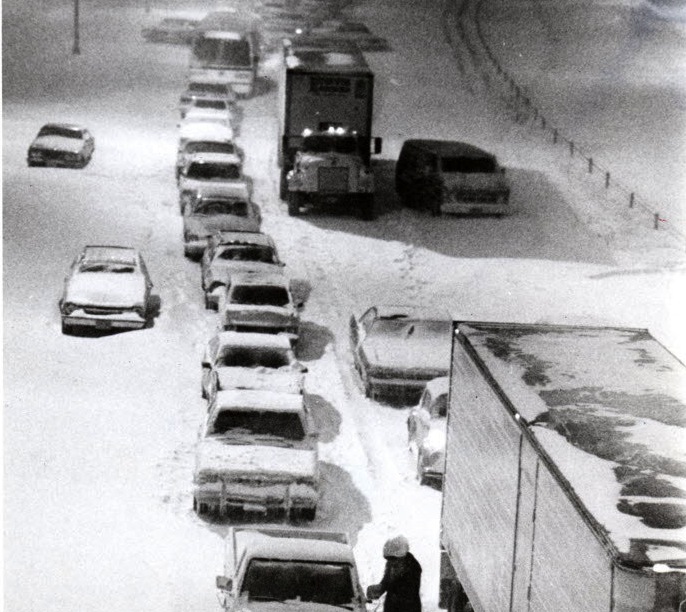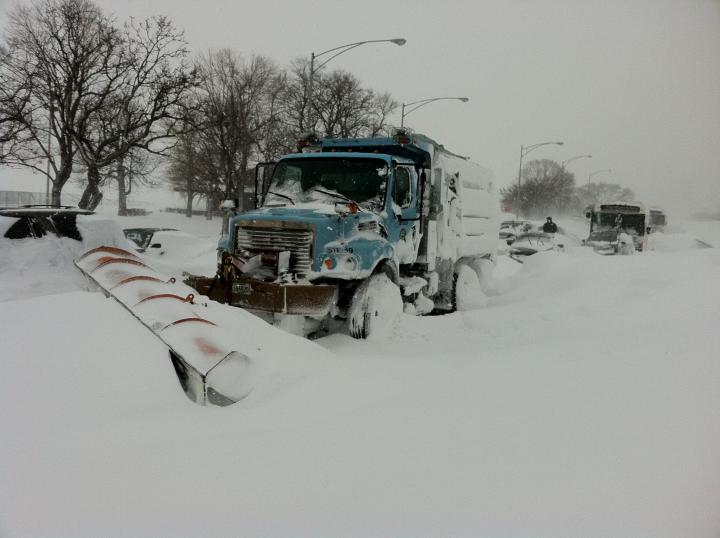
THE BLIZZARD OF ’78 PILED UP CARS ON ROUTE 128 IN NEEDHAM, MASSACHUSETTS, OUTSIDE BOSTON.
Looking Back at Memorable February Storms
ADVERTISEMENT
My 2 sons were sick with pneumonia. The baby was about 6 months old and the other son was 22 months old. The doctor told us to take them to Akron Children's to be admitted. The highways were shutdown due to the snow-in. We had to call the highway patrol and ask for them to escort us to the hospital. But I don't know what date this happened. My youngest son was 6 months old and he was born July 19, 1978. So what date did this particular storm hit Northeastern Ohio?
I was attending school at UConn in Storrs, CT, during the blizzard of "78. I was living in the one of the dorms on campus. I recall the snow being waist high and having drifts over my shoulders in places. We helped shovel some cars out to allow people to get home after a day of constant hard snow. Meanwhile, in "the jungle" portion of campus people were partying pretty hard with a day off of school. I'm told someone was using a third floor bathroom as a sauna, and people were jumping out of the third floor window after the sauna in various states of undress. Unfortunately, the snow pile below the window began to compress, and someone broke his ankle in the snow pile. Fortunately, the person was not lying in the snow pile too long before medical care arrived! Kudos to the fire department!
July is generally the driest month in these parts. February is the 3rd wettest month.
Dayton, OH - My sister didn't want to go to school the next day and asked for snow in her bedtime prayers. Dad said he still would have to go to work so she ammended her prayer to "Please make it snow hard enough Daddy doesn't have to go to work" The blizzard the next day closed the school and Dad's regular job but he worked part time for the fire department rescue squad so he worked anyways...
Thanks for sharing, Katie. This sounds like a story that you and your family share and remember fondly.
The first one was March 1963, I was 11 years old and my family & I were returning to
Belle Fourche, South Dakota. I could not even tell you the day in any case we were driving on HWY 212 from Watertown (my Father's hometown) on our way to Belle Fourche, SD. We were driving along and it was snowing and my Uncle was driving and he just happened to say that the weather was turning bad, of course there is not too many stops along this road. We went as far as we could and were stopped by a large snow drift or hill just had to stop where we were and hoped that someone would come checking. Well it was about 30 minutes a Sheriff on horseback came to our car, told his all the roads were closed, we were only 1 mile from Faith, SD. He said could take one on the horse with him, the others were to walk to the Faith Hotel. I went with the sheriff and my family was not far behind. We stayed there 3 days until the roads were opened. When we left the snow was pile at least 10ft high.
The next blizzard was 1968. We lived in Sandpoint, Idaho and the second week December it started snow and now I was a sophomore in High School. it kept snowing and we were still going to school everyday. It was piling up but this town is used to snow. But I remember on 12/12 that year we were released from school early because it was snowing really a lot. So we got out of school 12/12 and did not go back to school until January 1969. We missed 2 weeks of school before the Christmas break, then 2 weeks Christmas Break all the way through January I'm guessing the 10th. It was a long time, I will tell you the snow was piled in our front yard that we did not see our neighbors across the street until March. People were getting around with snowmobiles, and anyone with a car had bright orange balls on their antenna's of the cars so you see if anyone was coming at intersections.
Just two that stand out to me in my life.
Great stories, Diane! Those were the days. Makes me think of the Blizzard of 1978 in New England. These storms can be dangerous but there is also fascination and wonder about Mother Nature. Safe travels!
Thank you for sharing...I have family that lives in Watertown and I grew up in CA, love to hear about the different climate and lifestyle.
Julie
They didn't call it the Great White Hurricane for nothing. Winds were well over 100 MPH, I was 12 y/o and in 7th grade, We were dismissed early the previous day , before it started, The junior high principal announced, "Go straight home" .. I remember how scared he sounded. It was lightly raining then.
The next morning at 4;30 am, I woke up to hear wind, howl like I have never heard since. I was in Clyde Ohio then. We had gas stove and cooking by flashlight. I also remember after school resumed about 7 days later that we were walking in the street between 8 - 10 feet snow canyon walls. All of the walks were still buried, The National Guard was brought in to help clear roads.
Storms like that stay with you, and people still make fun of you about getting milk, bread before storms, But they've never been through anything like that. And 4 WD don't go through snow that high or they still slip/slide on ice, they get too cocky nowadays.
Seriously, Clyde, OH?? That's where I was!! Raining the night before; no indication of anything coming. Next morning, no electric/no school. Our landlord came and got us all out of our apartments and took us to his house . . . I didn't figure it was so bad until we walked around the corner of the apartment building and got hit by the wind!! Probably 10+ in their family room with a fireplace a couple days . . . Wow!! Yep, the snow was deep!! Something to always remember!!











